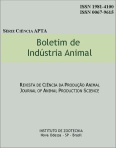Controlled exercise influence on reproductive performance of stallions
Abstract
A completely randomized design with 2 treatments and 2 experimental units per treatment was utilized. Treatments: A - 2 hours per day in paddock and riden exercise once a week; B- 6 hours par day in paddock and riden exercise every day. It was a 6 months experiment: 3 months before and 3 months during the breeding season. During the first 3 months, semen was collected twice a week and, every 14 days, the ejaculate was analysed and blood serum collected. Within the breeding season, the analyses of semen and serum collection were performed every 14 days, but if the stallion did not serve at least 2 mares per week, the semen was collected to provide a similar situation as the first period. The ejaculate average volume was different between treatments (69.90 ± 3.30 ml - A and 59.04 ± 3.16 ml - B); the stallion 1 average was higher than the average of the other 3 stallions. The number of ejaculated spermatozoa did not vary between treatments, consequently the concentration showed a lower on A. There was season effect on concentration; it was higher on the first period (266.63 ± 17.80 X 106 spermfml vs 162.57 ± 17.04 X 106 sperm/ml). Principal piece pathology was different between the two season, but probably due to animal variability. Excitation time was not affected by treatments but it was shorter during the second period (breeding season). The semen pH and glucose, calcium and phosphorus levels did not change. Each stallion bred at least 10 mares and the pregnancy rate (stallions 1, 2, 3 and 491.7, 72.2, 80.9 and 81.8%, respectively) did not show effect of treatment of season.Downloads
Downloads
Published
Issue
Section
License
Os autores não serão remunerados pela publicação de trabalhos, pois devem abrir mão de seus direitos autorais em favor deste periódico. Por outro lado, os autores ficam autorizados a publicar seus artigos, simultaneamente, em repositórios da instituição de sua origem, desde que citada a fonte da publicação original seja Boletim de Indústria Animal. A revista se reserva o direito de efetuar, nos originais, alterações de ordem normativa, ortográfica e gramatical, com vistas a manter o padrão culto da língua e a credibilidade do veículo. Respeitará, no entanto, o estilo de escrever dos autores. Alterações, correções ou sugestões de ordem conceitual serão encaminhadas aos autores, quando necessário. Nesses casos, os artigos, depois de adequados, deverão ser submetidos a nova apreciação. As opiniões emitidas pelos autores dos artigos são de sua exclusiva responsabilidade. Todo o conteúdo deste periódico, exceto onde está identificado, está licenciado sob a Licença Creative Commons Attribution (CC-BY-NC). A condição BY implica que os licenciados podem copiar, distribuir, exibir e executar a obra e fazer trabalhos derivados com base em que só se dão o autor ou licenciante os créditos na forma especificada por estes. A cláusula NC significa que os licenciados podem copiar, distribuir, exibir e executar a obra e fazer trabalhos derivados com base apenas para fins não comerciais.













